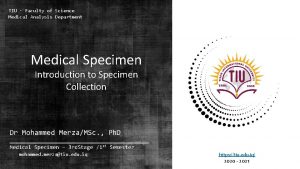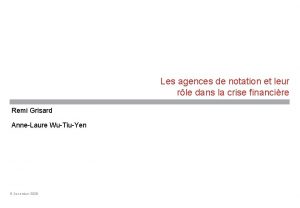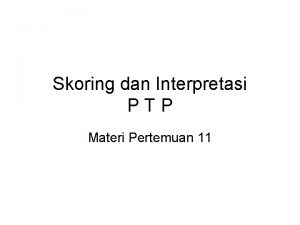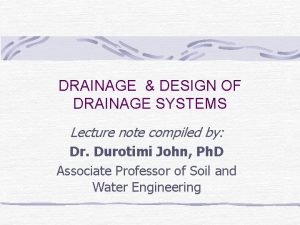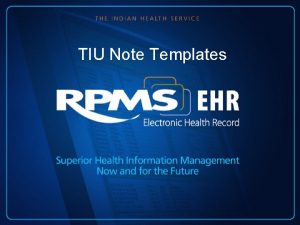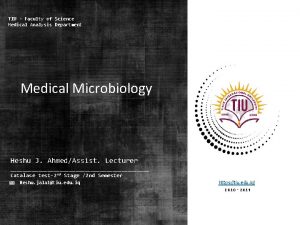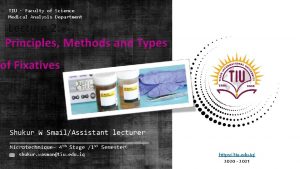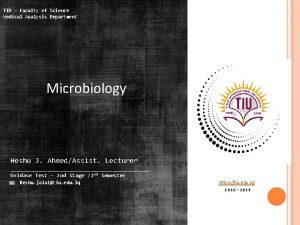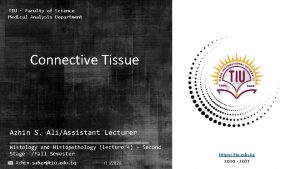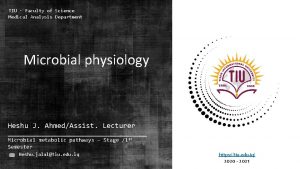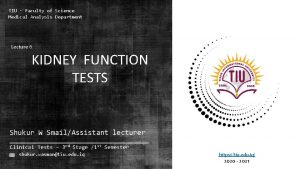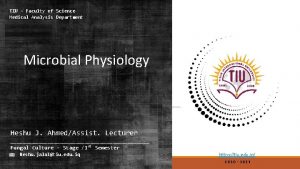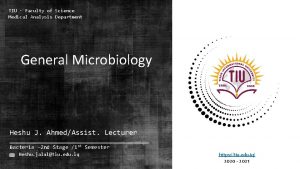TIU Faculty of Science Medical Analysis Department Medical











- Slides: 11

TIU - Faculty of Science Medical Analysis Department Medical Specimen Introduction to Specimen Collection Dr Mohammed Merza/MSc. , Ph. D _______________________ Medical Specimen – 3 rd. Stage /1 st Semester mohammed. merza@tiu. edu. iq https: //tiu. edu. iq/ 2020 - 2021

Introduction to Specimen Collection • Medical tests contribute vital information about a patient's health. • Correct diagnostic and therapeutic decisions rely, in part, on the accuracy of test results. Safety and Disposal Considerations in Specimen Collection In all settings in which specimens are collected and prepared for testing, laboratory and health care personnel should follow current recommended sterile techniques, including precautions regarding the use of needles and other sterile equipment.

Preparation Preparing the Patient. Provide the patient, in advance, with appropriate collection instructions and information on fasting, diet, and medication restrictions when indicated for the specific test. Preparing the Specimen. Verify the patient's identification. Proper identification of specimens is extremely important. All primary specimen containers must be labeled.

Avoiding Common Problems Careful attention to routine procedures can eliminate most of the potential problems related to specimen collection. General Specimen Collection. • Examine specimen collection and transportation supplies to be sure they do not include expired containers. • Label a specimen correctly and provide all pertinent information required on the test request form. • Submit a quantity of specimen sufficient to perform the test and avoid a QNS (quantity not sufficient), as indicated in the test requirements.

Serum Preparation. • Separate serum from red cells within two hours of venipuncture. • Mix specimen with additive immediately after collection. • Allow specimens collected in a clot tube (eg, red-top or gel-barrier tube) to clot before centrifugation. • Avoid hemolysis: red blood cells broken down and components spilled into serum. • Avoid lipemia: cloudy or milky serum sometimes due to the patient's diet (discussed under the section on lipemia). Plasma Preparation. • Collect specimen in additive indicated in the test requirements. • Mix specimen with additive immediately after collection by inverting 5 -10 times. • Avoid hemolysis or red blood cell breakdown. • Fill the tube completely, thereby avoiding a dilution factor excessive for total specimen volume (QNS). • Separate plasma from cells within two hours of venipuncture when indicated in the test requirements. • Label transport tubes as “plasma. ” • Indicate type of anticoagulant (eg, “EDTA, ” “citrate, ” etc).

Urine Collection. • Store unpreserved specimens refrigerated or in a cool place until ready for transport. • Provide patients with instructions for 24 -hour urine collection. • Add the preservative (as specified in the test requirements) to the urine collection container prior to collection of the specimen. • Provide sufficient quantity of sample to meet the minimum fill line on preservative transport container. • Provide the proper mixing of specimen with urine preservative as specified in the test requirements. • Use the collection container as specified in the test requirements, and refrigerate the specimen when bacteriological examination of the specimen is required. • Carefully tighten specimen container lids to avoid leakage of specimen. • Divide specimen into separate containers for tests with such requirements. • Provide a complete 24 -hour collection/aliquot or other timed specimen. • Provide a 24 -hour urine volume when an aliquot from the 24 -hour collection is submitted. • Preservatives vary for each test; refer to test information for the required preservative.

Preparing the Patient Instructions It is important to gain the patient's understanding and cooperation in obtaining an acceptable specimen. Patient States Basal State. In general, specimens for determining the concentration of body constituents should be collected when the patient is in a basal state (ie, in the early morning after awakening and about 12 to 14 hours after the last ingestion of food). Reference intervals are most frequently based on specimens from this collection period.

Exercise. Moderate exercise can cause an increase in blood glucose, lactic acid, serum proteins, and creatine kinase (CK). Emotional or Physical Stress. The clinical status of the patient can cause variations in test results. Time of Day of Collection. Diurnal variations and variations in circadian rhythm can also affect test results. For example, growth hormone peaks in the morning before waking and decreases throughout the day. Serum iron levels may change as much as 30% to 50%, depending on individual variation, from morning until evening.

Timed Specimens There are two types of timed blood specimens: Single Specimens. • Fasting plasma glucose alone or in conjunction with a random glucose determination, as recommended by the American Diabetes Association, to diagnose diabetes. • Fasting here is defined as no caloric intake for at least eight hours. • Postprandial glucose may be performed two hours after a meal for a timed test that is helpful in diabetes detection. • Blood glucose determinations may be ordered at a specific time to check the effect of insulin treatment. • Blood cultures may be ordered for a specific time if a bloodstream bacterial infection is suspected. • Therapeutic monitoring of patients on medication.

Multiple Specimens. • The most common timed procedure is a glucose tolerance test. • First, a blood specimen is drawn from a fasting patient. • Then, the patient is given glucose orally and blood specimens are drawn at fixed intervals. • The tolbutamide (Orinase®) test is similar to a glucose tolerance test, but the collection intervals vary.

Thanks for your attention mohammed. merza@gmx. us
